Canaryville Blues, Part I: Picturing Canaryville
CONCEPT
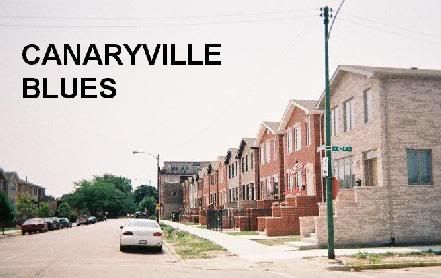
EDIT: This post contains my personal impressions of Canaryville as collected through July 2004 by visiting the neighborhood, reading, and interviewing residents. I undertstand that there are some factual errors here, but as this is not a project I am actively working on, I have not made changes. Thank you for any constructive criticism offered here.
- Connor Coyne, 4/4/2007
This past weekend, when I was still in Flint, I spoke with Dan Gerics from Flint City Theatre about submitting a script for their season next year. It's good for me; I haven't written many scripts lately, and resumewise, one script peformed is better than twelve on the page.
For this project, I returned to Canaryville Blues, which I drafted (in the broadest sense of the word) in late 99, and hope to absorb into Part 6 of Euphemism, a major project.
Canaryville strikes me as incredibly beautiful, contradictory, and fascinating... one of the most forgotten of Chicago neighborhoods, and that in spite of a complex and colorful history.
Canaryville is one of the stockyard neighborhoods on the South Side, closely tied to Bridgeport to the north, Fuller Park to the east, and Back of the Yards to the west. The borders on north and south are Pershing (39th) and the G.T.W. railroad, on east and west are the Penn-Central railroads and Halsted street. Those of you familiar with Chicago, and the South Side in particular, understand the fact that railroad tracks and industrial areas can more effectively isolate a neighborhood than expressways and rivers. Such barriers block out the view, and do not convey the same sense of commerce.
I believe that Canaryville was part of Forest Township during the late 1800s and was incorportated into the city of Chicago sometime following the establishment of the Union Stockyards. Canaryville was doomed by its situation above all else; while the stockyards were the largest employer on the South Side (and debateably Chicago), they created a reek that hung over the area like a pall and sometimes drifted as far as Hyde Park. Canaryville was the stockyards' front door, and so the stench overwhelmed and is even detectable today, thirty years after the stockyards closed.
The population very quickly became almost exclusively Irish, and rivalries between the Canaryville Irish and nearby Bridgeport Irish have spanned a century, and became so intense that Canaryville tends to back the Cubs (an act of high treason in the vicinity of Pershing). Because of its insolation, Canaryville remained largely Irish through to the present day, with a higher number of Irish households for population (and more active immigration from Ireland) than the more well -known neighborhoods of Bridgeport and Beverly.
In spite of this, Canarville is still a poor, inner city neighborhood with low-quality housing and a slate of industrial problems. Ethnic isolation has also led to ethnic strife. The African American influx to nearby Englewood and Fuller Park, and the post-World War II decline of those neighborhoods has fostered in Canaryville a sort of siege mentality. While this has begun to crack, largely with the bussing of out-of-neighborhood kids to Tilden, a large public high school, Canaryville has connections to some of Chicago's most notorious racism, including an incident in which a black boy was left in the neighborhood by the police, only to be promptly beaten to death, and the inciting event of the 1919 race riots.
Today, the neighborhood retains a strong Irish flavor, but many newer arrivals are Mexican and African American. I mentioned that Canaryville is beautiful to me. In many of Chicago poorer neighborhoods, it is clear where residents have taken pains to fix up their property. Canaryville is filled with this sort of effort, being dominated by single-family homes, but the raw materials are more limited. That is, the neighborhood is flat and overshadowed by industrial debris on all sides. The western half is covered with a perpetual stench that makes one's chest hurt until she is used to it. Housing stock is almost all frame, and even the most expensive older homes have been covered with shake and vinyl siding, hiding any remants of original stonework. Canaryville is also the sort of neighborhood where residents are born, live for generations and die. While the stockyards themselves have closed, many residents still work at the Stockyards Industrial District installed afterwards.
All of this combines to form an intriguing, insulated patchwork of open industrial space and mixed residential clusters.
UNION STOCKYARD GATE
A National Historic Landmark in Chicago, the Union Stockyard gate was built around 1875, early in the century long career of the Union Stockyards. The Stockyards are most notoriously known through Sinclair's The Jungle, but the immensity of the industry, which employed over 20,000 workers and, at its height, slaughtered hundreds of thousants of hogs and cattle a day isn't apparent until one walks along the mile-long complex. The gate itself was designed by the architect Burnham, whose name is all over Chicago parks and buildings, for the Armour company. The steer's head carved in center is supposedly modeled on "Sherman," a prize winning cow belonging to a stockyard founder.
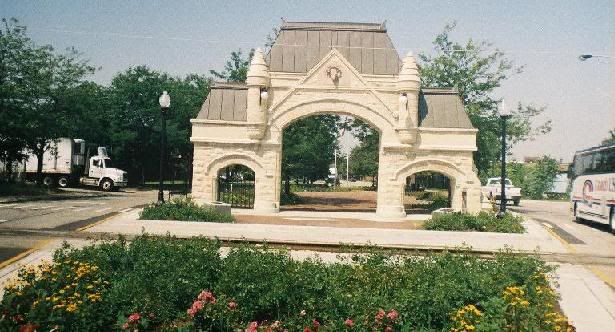
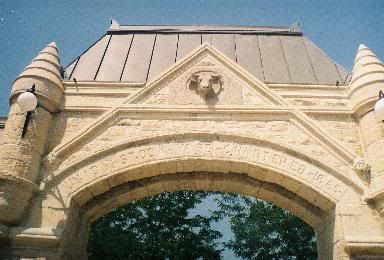
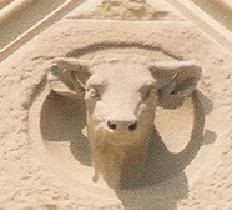
Sherman
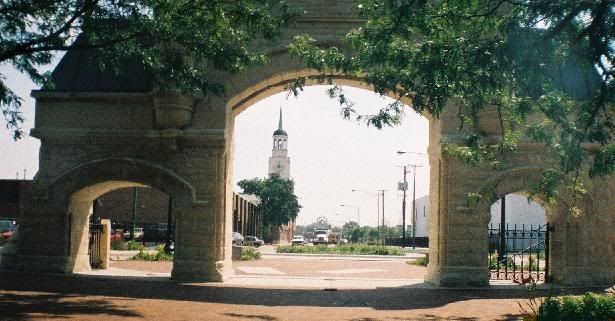

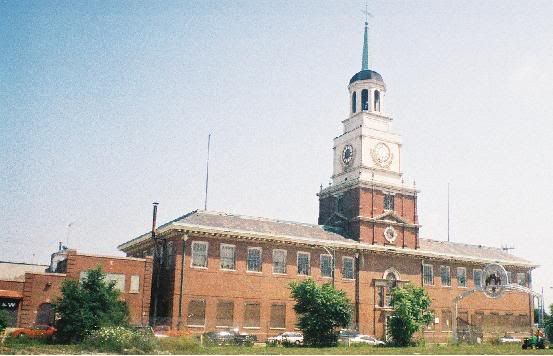
EDIT: I found out. This was the Union Stockyards Bank.
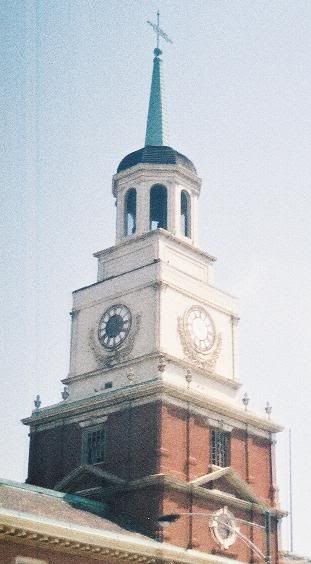


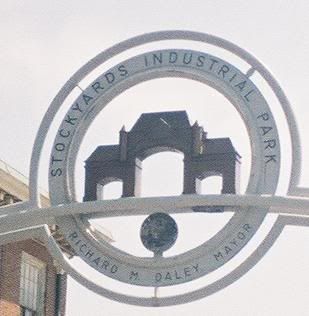
HALSTED STREET
While Halsted is the only major thoroughfare passing through Canaryville, it does not create a favorable impression. The western side of the street is dominated by industry, and the signature Packingtown stench is at its most powerful here.
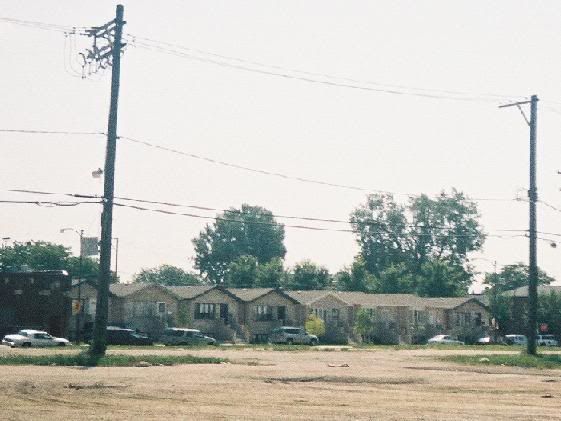
Our first view of the "Canaryville Bungalow."
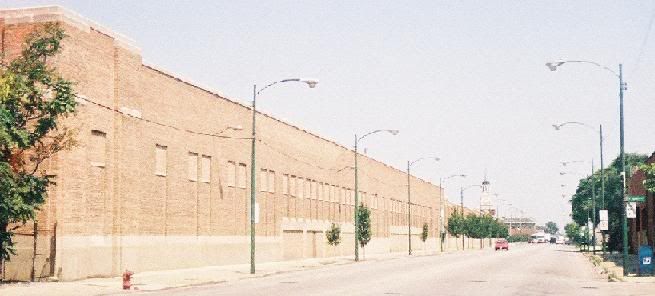
The International Amphitheatre.
EDIT: Evidently this used to be a venue of some magnitude, which surprises me given its lowness. It occurs to me that perhave the interior is depressed, because it was apparently used for sporting events, concerts, and various conventions.
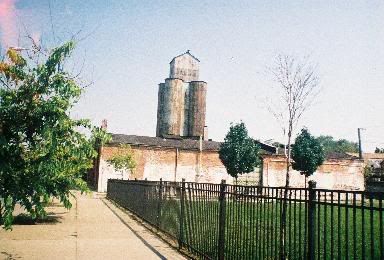
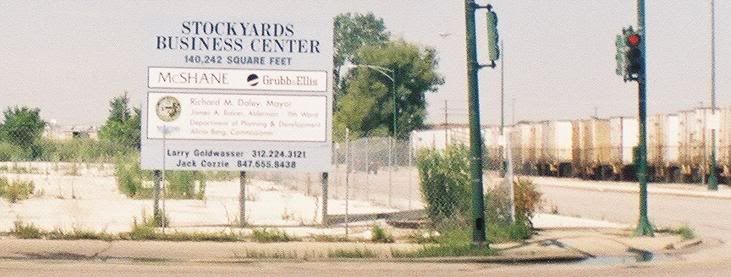
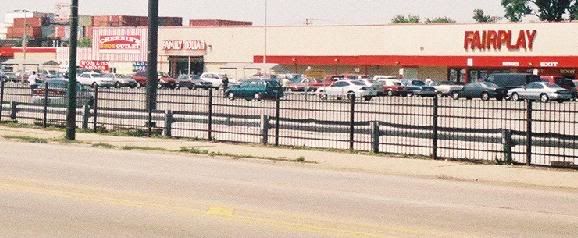
Hart Plaza.
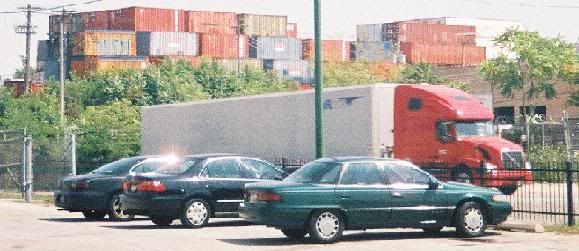
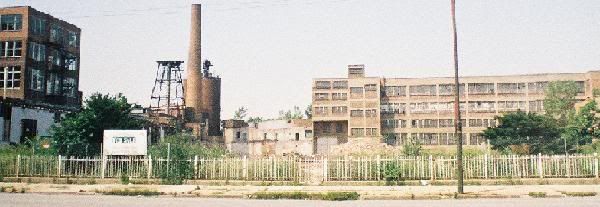
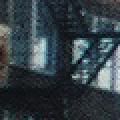
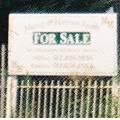
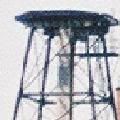
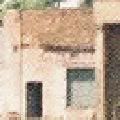

SOUTH OF 47th
The poor side of Canaryville.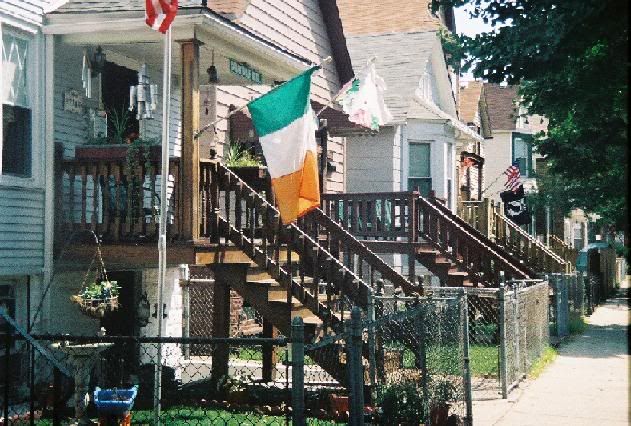
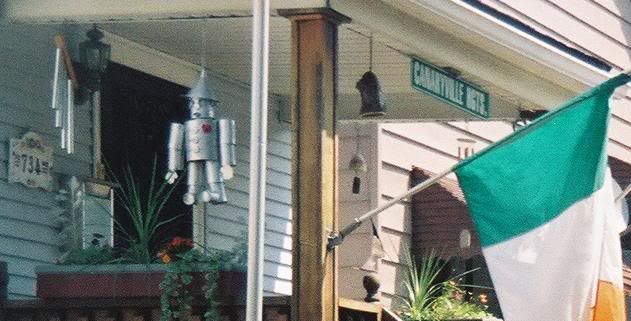
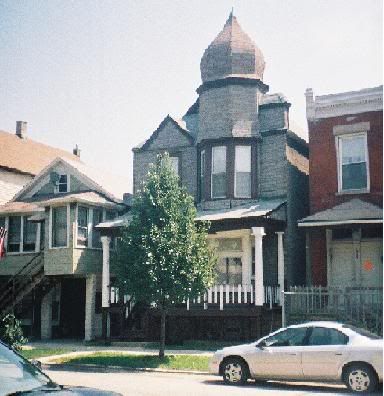
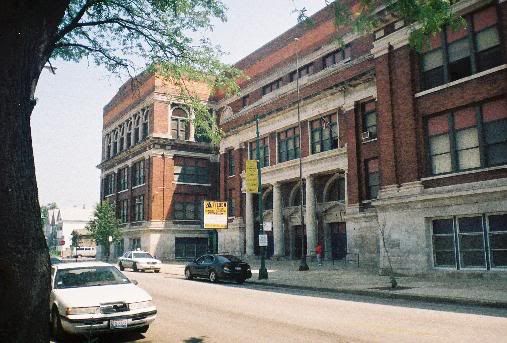
NORTH OF 47th
The more affluent part of Canaryville.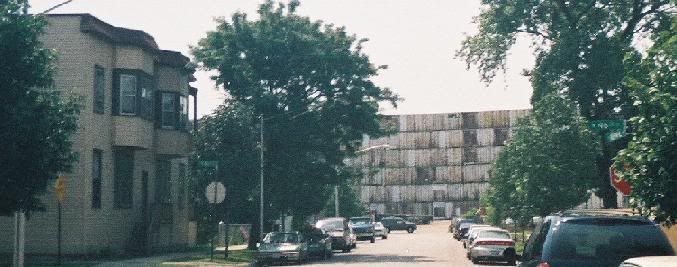

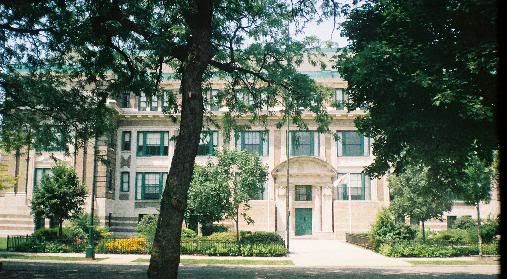
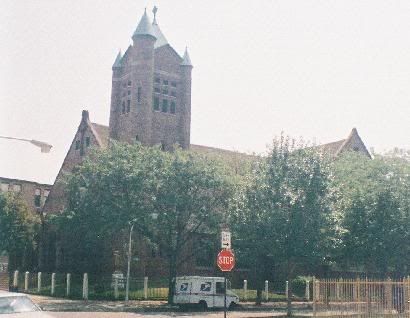
I have to admit, this is a gorgeous building, in what seems to be a very active parish.
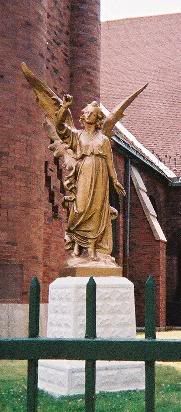
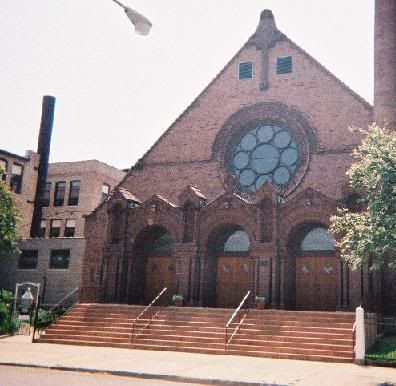
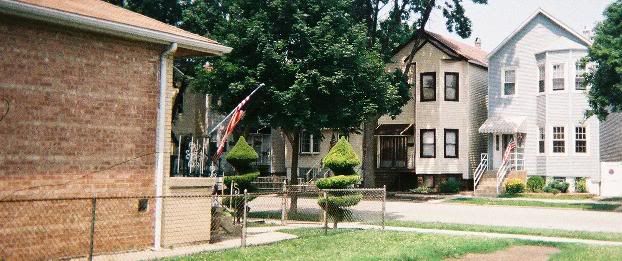
Count the flags.
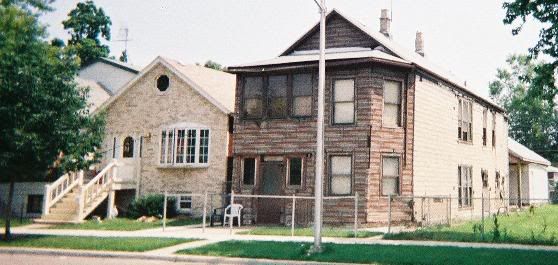
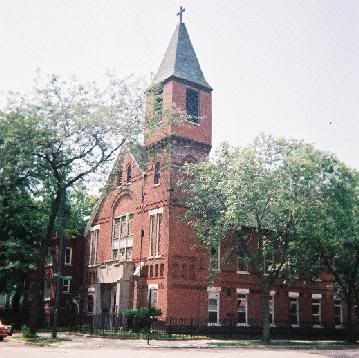
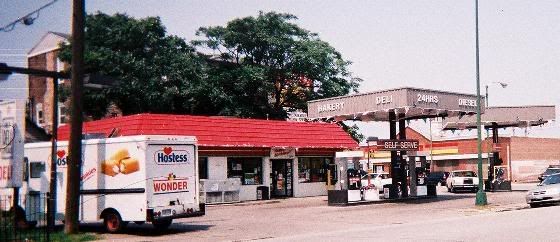
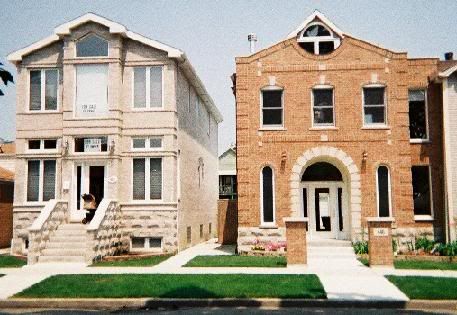
Huge and Ugly Yuppie Houses have found their way even here...
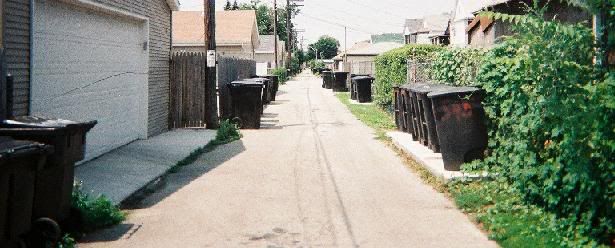
Canaryville alley.
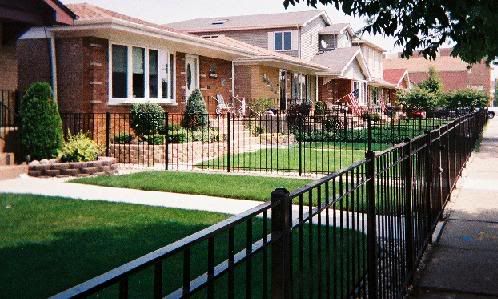
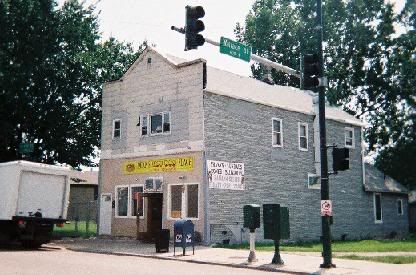
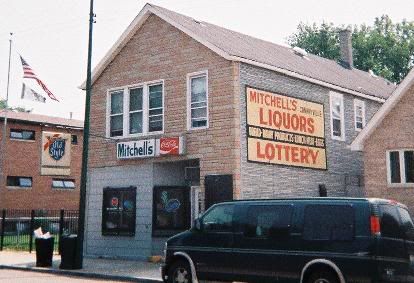
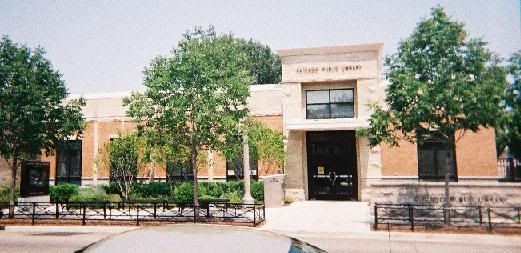
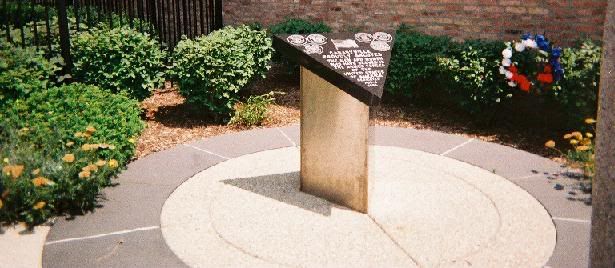
ROOT and PERSHING
The Northern border of Canaryville is as heavily industrial as Halsted Street.
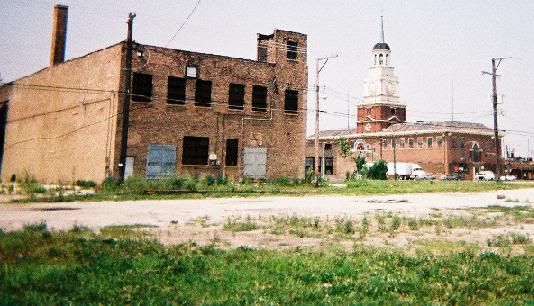
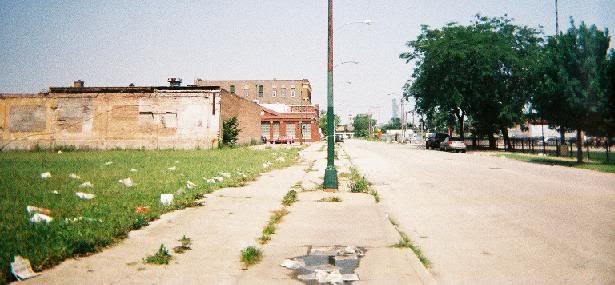
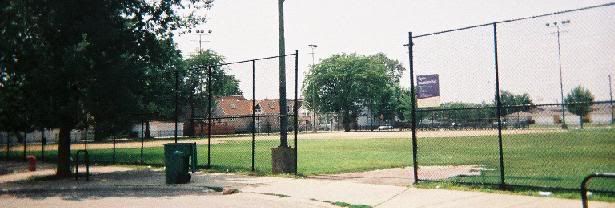
Taylor-Lauridsen Park.
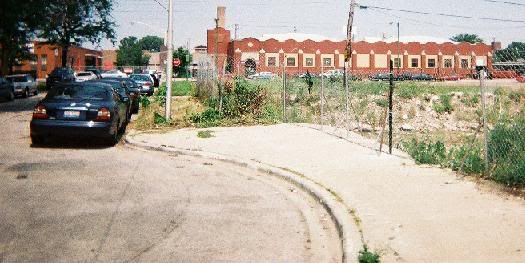

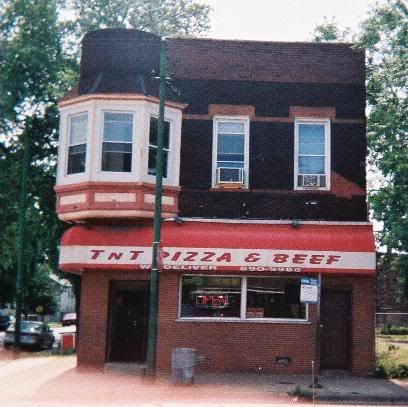

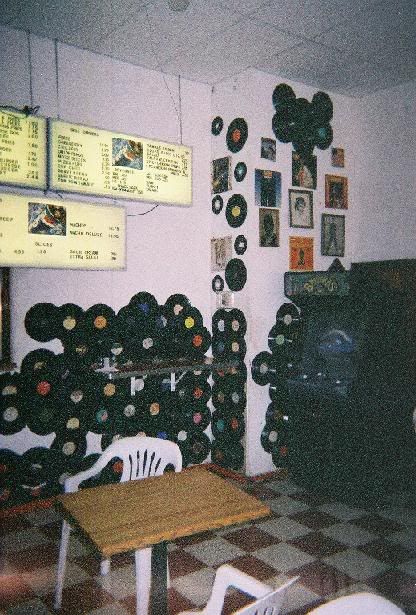
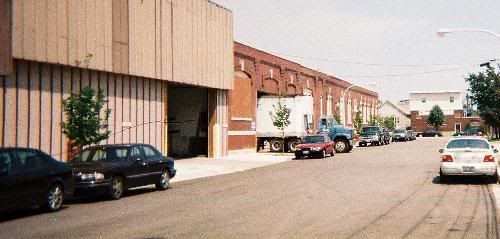
Goodbye Canaryville.
* * * * *
COMMENT, 3/31/2006.
I've finally gotten tired of getting spam comments and flames from people, so I decided to take the comments down. People negatively responding to this post almost universally show how carelessly they have read it by not:
1. Responding to or addressing the positive things I say about Canaryville.
2. Responding to or addressing the fact that the most controversial statements were made by Canaryville residents I interviewed.
3. Acknowledging the fact that this is a "context" post for insight not a finished project, that the project itself was not developed after 2004, and that everything is laid out as a work-in-progress.
If you all thought you could disprove some stereotype by leaving a bunch of nasty comments, you're mistaken. I don't have to change anything, and I'm disinclined to both respond to suggestions given in the form of insults or to provide a forum for your ranting.
I have taken the time to respond to some of the more reasonable comments people have left. All in all, this is a stupid thing to be upset by because nobody reads this post anymore except Canaryville residents digging for photos of Canaryville. If you're genuinely concerned about the reputation of your neighborhood, I'd like to make two suggestions.
First, write a nasty letter to Chicago: Not for Tourists. They say a lot of awful things about your neck of the woods without mentioning any of the history or positives that I've presented. I can promise you more people read their guides than my two-year old blog archives.
Second, if a writer/musician/artist/whatever says something you disagree with, instead of posting your angry thoughts in a public forum, send a thoughtful, critical email presenting your concerns. It is certainly more likely to get a fair reading and make a difference. (Myself, if you have to contact me, there is a contact form on my website here).
In closing, I would like to mention that while the posted comments were generally negative, I received a number of emails (overally, more coherent and thoughtfully written) during August and September 2004, when I was working on this play. About half of them were positive, and a lot of people appreciated that I was approaching Canaryville as a dynamic, changing community. If you reread these three posts, I think it's pretty clear that, regardless of whether or not you agree, I'm not trying to "slam" your neighborhood.
A lot of what I found so compelling about Canaryville (which I visited over a dozen times between 1999 and 2004) was its struggle for self-definition throughout a complicated, contradictory, and epic history. Canaryville, like my hometown, Flint, has both bright spots and a lot of issues, and these are part of what makes such communities unique. Do you really want to wash over that and pretend it's not there?
~ Connor

10 Comments:
the stockyards building is called Livestock national bank.
the school is really a Chicago public school named Alexander Graham
nice site... the international amphitheater was the site of the 1968 Democratic Convention where really bad riots took place.
i spent the first 7 years of my life in canaryville, until we moved to the "suburbs", because my sister was getting in knock-down-drag-
outs. it was, and probably still is a tough neighborhood, but even though i spent such a short time of my life there, i truly have good memories. great french frys at a store on the corner. ice skating in the pond/park off of union, and family. my real curiosity recently was to see if the old house was still standing. it was a big stone monstrosity, that probably shined in it's day. but most of all that house had an evil presents, a full
body apparition haunting a bedroom off the alley way. this was the real thing, no strings attached. hopefully she has gone into the light or the fire, or where ever
spirit go, because that room was cold and creepy. no one
would sleep in there. i would love to know it's early history. the apparition wore a white blouse with a high collar and a long black skirt, turn of the century.
What a great site.
I want to get to know every Chicago neighborhood for film and story purposes. I've loved exploring Bridgeport for the last 3 years and I guess Canaryville should be next. I wonder what those buldings are every time I drive down Halsted. I thought the International Amphitheater was torn down. I guess I forgot where it was. I used to see bands like Areosmith there in the 70's.
1968 Democratic Convention did take place at the Amphiteater but the riots did not take place there but in Grant Park, Downtown. Cops had the theater on lock down. I live on 55th and Halsted back then and could not get past 51st St during the convention. Great concerts at the Amphitheater as well as old time wrestling that my dad loved. Anyone out there remember Dick The Bruiser and the Crusher? They would drink a couple of beers at a bar across the street from the Amphitheater and then go kick ass. I am a Tilden Hich School 1972 graduate. Lots of racial and gang conflict during my time there. Rarely a gun was involved. Back then we went "mano a mano". may the best man (or woman) win.
My great grandmother called canaryville home during the turn-of-the-century. I believe her house is still standing....forgot the streets though :/
23 years old born n raised in the ville, I could take you through every alley or gang way and tell you an amazing story or memory that I have had there. 100% of my entire family still lives here on 43rd PL on the same street that I grew up on. Kennedy2390@gmail.com
Connor, there is ignorance everywhere and you have to put some comments/reactions in perspective. My family lived there for over 100 years and I feel that I have a special perspective, but not the only one. Overall, you did a magnificent job. Ignore the less initiated, there's quite a human story there that continues to develop.
Born n raised in the Ville. Not there now though. Only 1 sibling left there . I go back as often as I can. You had a lot of misinformation not your fault you need to live there to know it.great hood, I think about moving back
Post a Comment
Subscribe to Post Comments [Atom]
<< Home